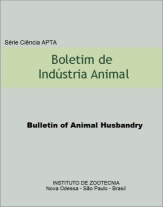Performance and carcass traits of lambs fed different types of silage
DOI:
https://doi.org/10.17523/bia.v73n2p143Keywords:
sweet potato, elephant grass, commercial cuts, fat thickness.Abstract
To evaluate the influence of different types of silage on the performance and carcass traits of feedlot lambs, 15 intact Santa Inês lambs with a mean age of 3 months and mean initial live weight of 18.7 ± 2.5 kg were used. The animals were randomly assigned to the following treatments, with five repetitions per treatment: corn silage, elephant grass silage with 15% corn meal, and sweet potato silage produced from the aerial part with 15% corn meal. Roughage corresponded to 50% of dietary dry matter. There was no difference (P>0.05) in carcass traits or commercial cuts, probably due to the chemical composition of the diets and because dry matter intake by the animals was similar between treatments. Silage produced from the aerial part of sweet potato and elephant grass silage do not affect performance, carcass traits or meat cuts and can be recommended based on nutritional evaluation for the feeding of feedlot lambs.
Downloads
Downloads
Published
Issue
Section
License
Os autores não serão remunerados pela publicação de trabalhos, pois devem abrir mão de seus direitos autorais em favor deste periódico. Por outro lado, os autores ficam autorizados a publicar seus artigos, simultaneamente, em repositórios da instituição de sua origem, desde que citada a fonte da publicação original seja Boletim de Indústria Animal. A revista se reserva o direito de efetuar, nos originais, alterações de ordem normativa, ortográfica e gramatical, com vistas a manter o padrão culto da língua e a credibilidade do veículo. Respeitará, no entanto, o estilo de escrever dos autores. Alterações, correções ou sugestões de ordem conceitual serão encaminhadas aos autores, quando necessário. Nesses casos, os artigos, depois de adequados, deverão ser submetidos a nova apreciação. As opiniões emitidas pelos autores dos artigos são de sua exclusiva responsabilidade. Todo o conteúdo deste periódico, exceto onde está identificado, está licenciado sob a Licença Creative Commons Attribution (CC-BY-NC). A condição BY implica que os licenciados podem copiar, distribuir, exibir e executar a obra e fazer trabalhos derivados com base em que só se dão o autor ou licenciante os créditos na forma especificada por estes. A cláusula NC significa que os licenciados podem copiar, distribuir, exibir e executar a obra e fazer trabalhos derivados com base apenas para fins não comerciais.













